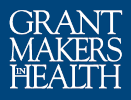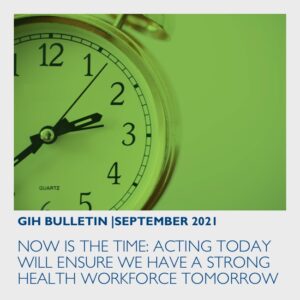Cara V. James, PhD, President and CEO, Grantmakers In Health
The COVID-19 pandemic has highlighted and exacerbated, among other things, our nation’s pressing health care workforce needs. Innumerable articles have been written about provider burnout, nursing home shortages, mental and behavioral health provider gaps, and public health burnout. The 7-day COVID-19 case rate in rural counties is higher than it has been at any point during the pandemic, leading some places providers to initiate crisis standards of care. Hospitals that can afford to are increasing rates for traveling nurses to fill acute needs, further contributing to the existing workforce shortage (NBC 2021) (Modern Healthcare 2021). Nationally, more than 84 million Americans live in a primary medical Health Professional Shortage Area (HPSA), more than 125 million live in a mental health HPSA, and more than 61 million live in a dental HPSA (BHW, HRSA, DHHS, 2021). To remove these designations, we would need to secure an additional 15,000 trained primary care providers, nearly 11,000 dentists, and over 6,500 mental health providers.
Given these challenges and consistent reports of provider and public heath burnout, I have been struck by the lack of a national dialogue or strategy to address our country’s health workforce needs. It is difficult to think about the future when we are still struggling to get the pandemic under control, but—given how long it takes to train providers—I do not think we can wait any longer to address our health care workforce challenges. And while the government remains stretched due to the pandemic, philanthropy can help advance the conversation on our health workforce needs, and can provide leadership in five key areas.
Developing a national strategy and an integrated approach to health workforce development
Many health care providers work in teams, yet much of our dialogue about the health workforce is siloed. Some of our definitions are even siloed. For example, according to the Health Resources and Services Administration, “The formula used to designate primary care HPSAs does not take into account the availability of additional primary care services provided by nurse practitioners and physician assistants in an area.”
In May, the Biden Administration announced that it plans to use $7.4 billion from the American Rescue Plan to increase the number of public health workers available to respond to the pandemic and prepare for future public health needs. More than half of this money will be used to respond to the pandemic, but the Centers for Disease Control and Prevention is expected to use $3 billion to establish a new grant program to help grow and modernize the public health workforce at the state and local level. Additional resources are available through the Coronavirus Aid, Relief, Economic Security (CARES) Act of 2020, and the Provider Relief Fund (Health Affairs 2021).
The resources provided by the various pandemic bills are important but are not sufficient to solve our workforce problems. In the absence of a comprehensive plan that addresses workforce shortages, provider maldistribution, lack of diversity, future care delivery needs, misaligned incentives, and provider wellness and retention, our health workforce will continue to struggle to meet the country’s needs.
Establishing a national health workforce commission
The Affordable Care Act included numerous provisions that sought to address health care workforce shortages, such as creating loan repayment programs for primary care doctors, pediatric specialists, and the public health workforce; expanding loan programs for nursing students; eliminating the cap on the commission corps; and providing grants to schools to train more providers in general, pediatric, and public health dentistry.
Section 5101 established a national health care workforce commission, but the divisiveness surrounding the law meant that resources for the commission were not appropriated, and it never got off the ground. The commission was to work across departments with health care workforce programs to provide an annual review of the health care workforce and make recommendations to Congress and the administration regarding the following issues:
- workforce supply and distribution; education training and capacity;
- education loan and grant programs;
- implications of new and existing federal policies affecting the workforce;
- health care workforce needs of special populations, such as minorities, rural populations, medically underserved populations, gender specific needs, individuals with disabilities, and geriatric and pediatric populations; and
- creating or revising loan repayment programs and scholarship opportunities to improve access to care in medically underserved areas.
The need for a health workforce commission has not gone away; if anything, events of the past year and a half have highlighted how greatly the need for the commission has grown.
Making diversity, equity, and inclusion central to any workforce strategy
Recent social unrest and the awakening to long-standing racial inequities led to increased attention on diversity, equity, and inclusion (DEI), and many newly created DEI and health equity positions. This presents a significant opportunity to implement programs and policies that will lead to significant and much needed improvements in the diversity of our health workforce. For example, Blacks and Latinos comprise 31 percent of the U.S. population, but only make up roughly 11 percent of all physicians in the U.S., compared to 46 percent of the direct health care workforce, for example personal care aides, home health aides, and nursing assistants (AAMC 2018) (PHI 2017). Hospital leadership and boards also lack diversity, potentially limiting efforts to advance health equity.
Pathways to health professions start well before college. Unfortunately, students of color, rural students, and students with disabilities often have fewer opportunities, in part because they are more likely to be from lower income communities. Schools in lower income communities tend to have fewer resources and opportunities, resulting in higher student-teacher ratios, fewer afterschool programs, fewer counseling services and curriculum offerings, and lower graduation and post-graduate participation rates. Fewer students pursuing post-graduate education means fewer professionals to diversify leadership positions across all sectors. Eliminating education disparities, then, is critical to establishing a diverse and culturally competent health workforce.
Collecting better data to improve our understanding of our and future current workforce
The COVID-19 pandemic has emphasized the need for better data to identify and monitor progress in addressing health disparities, yet less attention has been given to the data needed to improve our understanding of the health workforce. While at The Centers for Medicare & Medicaid Services (CMS), I worked with colleagues to change the Medicare provider database to collect information on provider demographics, including race, ethnicity, languages spoken in the practice, and accessibly for persons with disabilities. It will be a while before there will be enough data to be useful but, eventually, this information will support individuals to choose providers that best meet their needs. Better data on those providing care and supporting the health workforce at all levels of care—and across all settings—can help improve retention, support more equitable opportunities for career advancement, and increase the availability of culturally competent care. It can also help us to evaluate the impact of program and policy changes on different providers.
Helping to build the health workforce we need
Philanthropy has always had a role in training future health workers. Programs such as the Ford Foundation’s predoctoral, dissertation, and postdoctoral fellowships; Robert Wood Johnson Foundation (RWJF) Health Policy Scholars Program; National Academy of Medicine Scholars in Diagnostic Excellence, funded by the Gordon and Betty Moore Foundation; Commonwealth Fund Fellowship in Minority Health Policy at Harvard University; and the now defunct W.K. Kellogg Fellowship in Health Policy Research—of which I was a recipient—have provided direct training and support to advance careers in health. Other programs, such as the RWJF Summer Health Professions Education Program, have also played an important role in exposing students to health careers. Unfortunately, several programs no longer exist, though the need remains.
In addition to providing direct training support for future health workers, health funders have also funded studies of the health care workforce at a national, state, and local level. A few years ago, The California Endowment, Blue Shield of California Foundation, The California Wellness Foundation, the California Health Care Foundation, and the Gordon and Betty Moore Foundation pooled resources to support the California Future Health Workforce Commission. For more than a decade, RWJF has sponsored several studies on nursing, including The Future of Nursing 2020–2030: Charting a Path to Achieve Health Equity through the National Academy of Medicine.
Health funders can help support state and local health care workforce needs assessments and planning activities and can push for national action to advance an integrated and holistic approach that is equity focused. This will help reduce the risk that strategies to address workforce challenges in one area will not deplete resources in another community.
The need to develop and implement a comprehensive integrated plan to address our health workforce grows stronger every day. As some communities experience their highest COVID-19 case rate since the start of the pandemic, with providers and public health workers stretched to the breaking point, we must also devote time and resources to ensure that we have a highly trained, diverse health care and public health workforce to meet our future health needs.
References
AAMC. “Diversity in Medicine: Facts and Figures 2019,”
Armstrong, David; Beck, Angela; Buerhaus, Peter I.; Fraher; Erin P.; Frogner, Bianca K.; Moore, Jean; Pittman, Patricia; and Spetz, Joanne. “Investing In A 21st Century Health Workforce: A Call For Accountability,” Health Affairs, September 15, 2021.
Bureau of Health Workforce, Health Resources and Services Administration, U.S. Department of Health & Human Services. “Designated Health Professional Shortage Areas Statistics,” June 30, 2021.
Campbell, S. Racial and Gender Disparities Within the Direct Care Workforce: Five Key Findings. November 2017. PHI. Bronx, NY.
Miranda, Leticia, “Rural hospitals losing hundreds of staff to high-paid traveling nurse jobs,” NBC News, September 15, 2021.
“Travel nurses ‘a double-edged sword’ for desperate hospitals,” Modern Healthcare, September 15, 2021.

